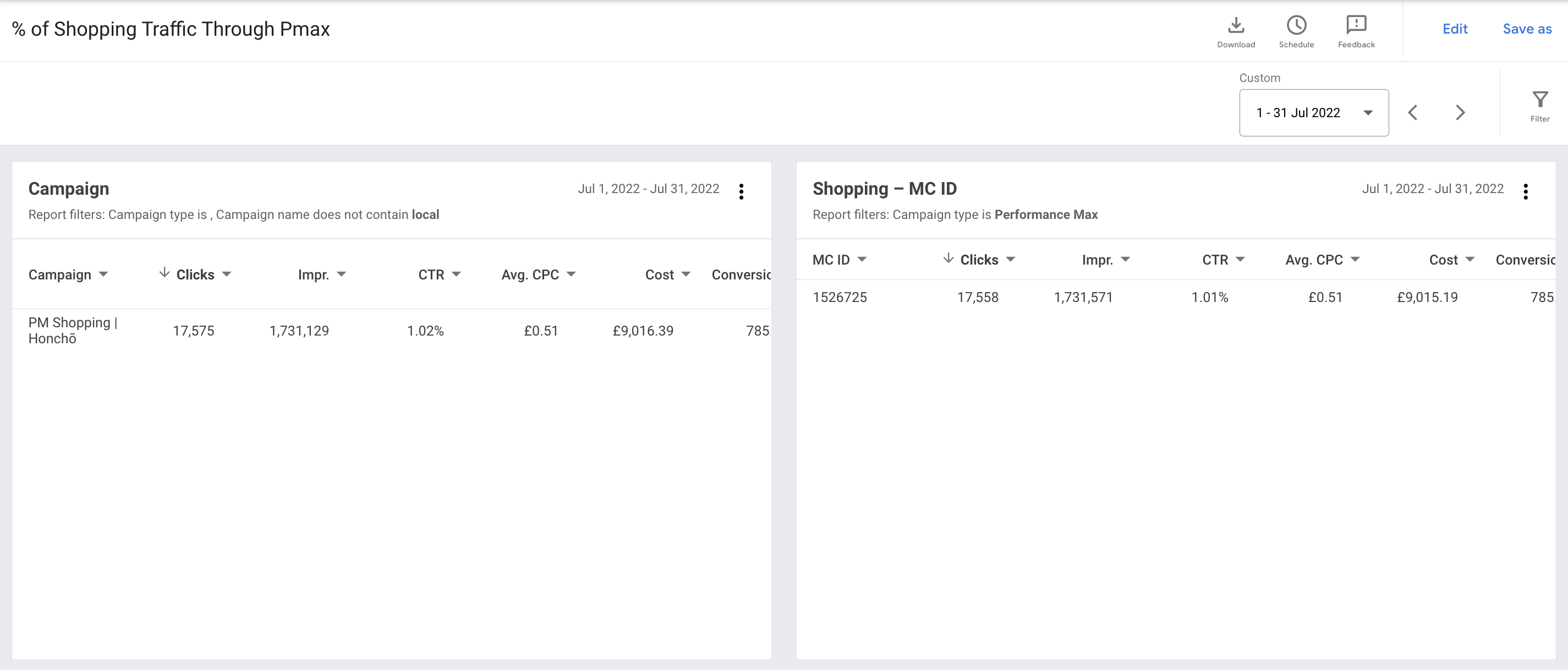3 min read
Honchō Scoops Up Two UK Search Awards!
It’s official, we've added not one, but two shiny trophies to our awards cabinet! We’re over the moon to share that we’ve triumphed at the UK Search...
5 min read
 Cristi Macfarlane
:
Aug 12, 2022 11:30:06 AM
Cristi Macfarlane
:
Aug 12, 2022 11:30:06 AM

The value of Performance Max campaigns comes from being able to automatically target in-market users across all Google networks (Search, YouTube, Shopping, Display, Gmail). However, we’ve found that there’s the potential to waste up to 30% of the budget when running across all of these networks.
Creative assets in Performance Max refer to the videos, images, headlines and descriptions which can be applied when setting the campaign up. Having these assets is what allows the campaign to run across multiple networks. But by skipping the assets page and running with just a feed, it’s possible to force traffic through shopping specifically, which is particularly important for those wanting to use Performance Max primarily as a shopping campaign.
Across our own e-commerce clients, we’ve found that running with no assets directs – on average – 98% of Performance Max traffic through shopping, which is accountable for 98% of sales and 99% of revenue. Running with assets reduced shopping traffic to 81%. However, this 81% is accountable for 94% of Performance Max sales and revenue.
In one stark example, 70% of shopping traffic was driving 98% of sales and revenue for a campaign using assets, suggesting a wastage of nearly 30% through the additional non-shopping networks.
Whilst there’s potential for these additional networks to result in a halo effect on the wider business, this wasn’t reflected in the figures from our accounts using data-driven attribution (DDA). With DDA in place, a % of a conversion is allocated to each channel that played a part, meaning if non-shopping traffic was having an effect on longer-term performance, we’d still see this reflected in the conversion data for Performance Max.
However, across these particular campaigns, we see the same trend with 82% of shopping traffic driving 98% of Performance Max sales and revenue.
What is apparent from this data is that the greater the % of non-shopping traffic, the more potential there is for wasted spend. With traffic coming from networks such as Display and Gmail – channels with historically poor conversion rates – these figures aren’t overly surprising. We found that the conversion rate for Performance Max campaigns without assets improved by +7% when compared to previous Smart Shopping performance.
However, our Performance Max campaigns with assets saw conversion rate decrease by -8%. Whilst there will be other factors at play, the data is otherwise showing that conversion rate decreases when non-shopping networks are driving a greater % of traffic.
Contact us for Performance Max Support!
Through our own data we found that as a minimum, 94% of traffic coming through Performance Max was shopping traffic when we didn’t use assets, which is particularly useful for those who want to use Performance Max primarily as a shopping campaign going forward.
Those with strict efficiency KPIs who want to ensure their budget is being spent where the return is stronger, or those with minimal budgets without the luxury to drive traffic from higher up the funnel, may also benefit from pushing more traffic through Shopping specifically.
Whilst seeing the performance splits between the different networks to easily identify wasted spend would be a nice-to-have, this isn’t readily available to advertisers, making it very likely that wastage may just go unnoticed.
Below is the workaround we use to work out the % of shopping traffic, sales and revenue coming through our Performance Max campaigns:
In the Reports section of Google Ads, set up a new Dashboard. Insert a ‘Campaign’ report on the left and a ‘Shopping – MC ID’ report on the right.

Filter both reports to only show the campaign type ‘Performance Max’ and include any metrics you would like to compare.

From here you can compare the difference between activity coming through Performance Max vs. activity coming through Google Merchant Centre. As the figures on the MC-ID report only show shopping figures, you can confidently estimate the number of shopping clicks, for example, that came through Performance Max. In the same way, you can calculate the % of clicks that came through non-shopping networks.

You will need to manually calculate the % difference between the numbers as this isn’t visible in the reports. In the above example, 17,575 clicks came through our Performance Max campaign in July, whilst 17,558 clicks came through the Merchant Centre, highlighting 17 clicks unaccounted for which will have come from the additional networks.
In this instance, 99% of Performance Max traffic is coming through Shopping specifically (note, this is a campaign without assets).
Whilst the option to run Performance Max without assets isn’t made too obvious in the set up, it is very simple. When setting up your Performance Max campaign from scratch, you’ll reach the header ‘Asset Groups’. Within this part of the set-up, you’ll be asked to provide assets such as:
When this page first loads, the final URL, logo & business name will already be populated and everything else will be blank. This is how you want to proceed – simply press next, launch your campaign and you’ll have a Performance Max campaign, with no image, video or text assets; rendering it as an exclusively shopping campaign.
If you have used Google’s one-click upgrade from Smart Shopping to Performance Max or created your Performance Max with assets already, unfortunately, you won’t be able to remove those assets.
Instead, you’ll need to create a new campaign, or asset group. If you’re creating a new asset group, you’ll need to provide a final URL and then can hit ‘next’ as you would if you were setting this up in a new campaign.
After configuring your campaign in this way, your Performance Max campaign will function almost identically to how Smart Shopping did previously.
Let’s achieve great results together
As with anything in Google Ads, there is no one-size-fits-all approach so we’d always recommend diving into your own data before making any decisions.
It’s important to recognise the benefits that using assets can have. As assets are what allows Performance Max to run on additional networks, using them can provide a cost-effective way to add another touch point in the user journey.
Whilst visibility on how this traffic performs isn’t visible to marketers, leveraging Performance Max to test this enables advertisers to be visible on these networks together, which in turn could help grow your upper funnel activity & brand awareness.
Utilising these networks to drive upper funnel traffic may be the catalyst for growth in other areas of the business such as organic – which could benefit from giving those upper funnel users an additional touch point and putting your brand at the forefront of their minds.
The likelihood is that users won’t initially convert from channels such as Display or YouTube but they may be influenced to convert later down the user journey. Moving to a data-driven conversion model – if you’re not already – will be key for tracking the success of these lower intent networks to recognise the true impact this activity is having on the business over a prolonged period of time.
Whilst we can conclude from our own data that we see nearly 30% wastage in spend when using assets, there were outliers in this trend. Notably, one campaign using assets had 96% of shopping traffic drive 98% of Performance Max sales and revenue, showing that not all campaigns will see such a high disparity between shopping traffic and total sales and revenue.
Again, this just goes to highlight that you will need to make decisions based on the data you see in your own account.
Performance Max is here to stay and we’re probably never going to have network-by-network options – so recognising what you want to get out of Performance Max is key for advertisers to configure their Performance Max campaign in a way that is optimal for their businesses’ goals and aspirations.
Performance Max will function as the primary shopping campaign for the foreseeable future, making it even more important to continue to analyse and test, ensuring you’re maximising your performance and minimising wastage.
Data and article by Cristi Macfarlane and Jack Grantham
Learn more about our Paid Media services here.
If you’re struggling to get your campaigns to run, here are three tips that may help:
If you want to learn more, check out our blog page, contact us for further questions or check out our services.

3 min read
It’s official, we've added not one, but two shiny trophies to our awards cabinet! We’re over the moon to share that we’ve triumphed at the UK Search...

5 min read
Understand ecommerce attribution models which attribution models can maximise your marketing efforts and ROI.

3 min read
Explore how social commerce is changing the way we shop online, blending social interactions with digital commerce for a seamless buying experience.